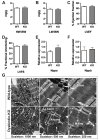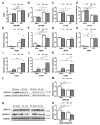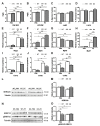Dysbindin deficiency Alters Cardiac BLOC-1 Complex and Myozap Levels in Mice
- PMID: 33142804
- PMCID: PMC7692170
- DOI: 10.3390/cells9112390
Dysbindin deficiency Alters Cardiac BLOC-1 Complex and Myozap Levels in Mice
Abstract
Dysbindin, a schizophrenia susceptibility marker and an essential constituent of BLOC-1 (biogenesis of lysosome-related organelles complex-1), has recently been associated with cardiomyocyte hypertrophy through the activation of Myozap-RhoA-mediated SRF signaling. We employed sandy mice (Dtnbp1_KO), which completely lack Dysbindin protein because of a spontaneous deletion of introns 5-7 of the Dtnbp1 gene, for pathophysiological characterization of the heart. Unlike in vitro, the loss-of-function of Dysbindin did not attenuate cardiac hypertrophy, either in response to transverse aortic constriction stress or upon phenylephrine treatment. Interestingly, however, the levels of hypertrophy-inducing interaction partner Myozap as well as the BLOC-1 partners of Dysbindin like Muted and Pallidin were dramatically reduced in Dtnbp1_KO mouse hearts. Taken together, our data suggest that Dysbindin's role in cardiomyocyte hypertrophy is redundant in vivo, yet essential to maintain the stability of its direct interaction partners like Myozap, Pallidin and Muted.
Keywords: Dysbindin; Muted; Myozap; Pallidin; cardiac hypertrophy.
Conflict of interest statement
The authors declare no conflict of interest. The funders had no role in the design of the study; in the collection, analyses, or interpretation of data; in the writing of the manuscript, or in the decision to publish the results.
Figures




Similar articles
-
Dysbindin is a potent inducer of RhoA-SRF-mediated cardiomyocyte hypertrophy.J Cell Biol. 2013 Nov 25;203(4):643-56. doi: 10.1083/jcb.201303052. J Cell Biol. 2013. PMID: 24385487 Free PMC article.
-
Reinvestigation of the dysbindin subunit of BLOC-1 (biogenesis of lysosome-related organelles complex-1) as a dystrobrevin-binding protein.Biochem J. 2006 May 1;395(3):587-98. doi: 10.1042/BJ20051965. Biochem J. 2006. PMID: 16448387 Free PMC article.
-
Identification of snapin and three novel proteins (BLOS1, BLOS2, and BLOS3/reduced pigmentation) as subunits of biogenesis of lysosome-related organelles complex-1 (BLOC-1).J Biol Chem. 2004 Jul 2;279(27):28393-401. doi: 10.1074/jbc.M402513200. Epub 2004 Apr 21. J Biol Chem. 2004. PMID: 15102850
-
The sandy (sdy) mouse: a dysbindin-1 mutant relevant to schizophrenia research.Prog Brain Res. 2009;179:87-94. doi: 10.1016/S0079-6123(09)17910-4. Epub 2009 Nov 20. Prog Brain Res. 2009. PMID: 20302821 Review.
-
Cell biology of the BLOC-1 complex subunit dysbindin, a schizophrenia susceptibility gene.Mol Neurobiol. 2011 Aug;44(1):53-64. doi: 10.1007/s12035-011-8183-3. Epub 2011 Apr 26. Mol Neurobiol. 2011. PMID: 21520000 Free PMC article. Review.
Cited by
-
Dataset of ileum bacterial diversity in mice after heart failure due to pressure overload.Data Brief. 2022 Jul 30;44:108498. doi: 10.1016/j.dib.2022.108498. eCollection 2022 Oct. Data Brief. 2022. PMID: 35966944 Free PMC article.
-
SRF: a seriously responsible factor in cardiac development and disease.J Biomed Sci. 2022 Jun 9;29(1):38. doi: 10.1186/s12929-022-00820-3. J Biomed Sci. 2022. PMID: 35681202 Free PMC article. Review.
References
-
- Yalcin F., Kucukler N., Cingolani O., Mbiyangadu B., Sorensen L., Pinherio A., Abraham M.R., Abraham T.P. Evolution of ventricular hypertrophy and myocardial mechanics in physiological and pathological hypertrophy. J. Appl. Physiol. 2019;126:354–362. doi: 10.1152/japplphysiol.00199.2016. - DOI - PMC - PubMed
Publication types
MeSH terms
Substances
LinkOut - more resources
Full Text Sources
Molecular Biology Databases
Research Materials
Miscellaneous

